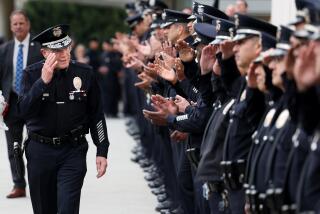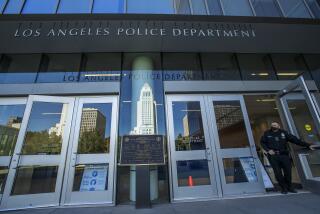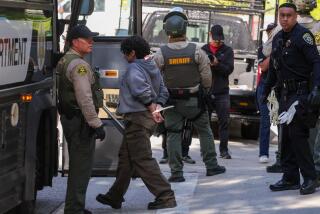What the Webster Commission Didn’t Say About L.A.’s Spring of Unrest : Riot report: LAPD intelligence was crippled by political interference, and the mayor’s public reaction to the verdict was incendiary.
Beginning April 29, Los Angeles saw the worst civil unrest in this country since the Civil War. As a result of on-the-spot television and media coverage, Southern California and the world would witness shocking images of barbaric savagery and physical brutality directed at innocent motorists who were dragged from their vehicles and beaten mercilessly.
In the midst of this maelstrom, the question that was found most often on the lips of the citizenry was, “Where are the police?”
In answering this question, the five-month study of the Los Angeles riots headed by former FBI Director William Webster should be looked at for what it left out as much as for what it tells us about the causes of the riots.
In an attempt to address the Los Angeles Police Department’s response, the Webster Commission produced a politically palatable report that blames the enormous eruption of violence on a combination of poor contingency planning by the LAPD and the failure of city officials, including Mayor Tom Bradley, to quickly marshal law enforcement help from nearby cities. The 300-page report ignores some of the most obvious causes of the escalation of violence and leaves out things that tend to support claims by then-Police Chief Daryl Gates that other factors contributed to the slow police response.
Hampered for months and second-guessed at every corner by politicians and community leaders, normal police operations were handcuffed. For example, after being lambasted by Councilmen Michael Woo and Zev Yaroslavsky for more than a year for conducting routine police intelligence, street police officers and those assigned to intelligence were too shell-shocked to do their job. As a result, normal intelligence-gathering--talking to “people on the street” and monitoring known criminals and troublemakers--came to a virtual halt.
When the breakdown in intelligence caused by outside interference was going to be exposed in the Webster report as a contributing factor to the riots, the report’s authors ordered it removed because it would tend to support Gates.
Then, only two days before the verdicts were handed down in the trial of four police officers in the Rodney King incident, Councilman Mark Ridley-Thomas and others warned police officials that a large presence in South-Central Los Angeles would threaten their constituents and inflame this already tense community.
Black ministers held a press conference that berated Gates for provoking ill feelings in the minority community by attempting to set up an “emergency fund” to pay overtime to police officers in case of rioting. Police management found itself trying to precariously balance between inciting a civil uprising and keeping the peace. The Webster report failed to mention this “Catch 22” situation, which is unparalleled in law enforcement.
Responding to the initial mayhem in which truck driver Reginald Denny was beaten, the Webster Commission, in a cowardly move, refused to name the politicians who had ordered the police to remain low-key after the verdicts. Instead, the report chose to castigate Gates for failing to fully estimate the magnitude of the reaction to the verdicts, for not having a “riot plan” and for not entering “hot spots” in large numbers quickly enough to quell the violence when it erupted.
In its analysis of the LAPD, the Webster Commission glossed over the fact that one of the underlying and fundamental reasons the LAPD failed to put down the rioting quickly was because the city of Los Angeles is grossly under-policed. At the time of the riots, the LAPD had about 8,000 officers to police a city with more than 468 square miles and a population of over 3.5 million people. Today, we have about 7,800 officers protecting our city.
To answer the question of under-policing in a politically correct manner, the Webster Commission encouraged putting more police officers on the street through the elimination of the highly successful Drug Abuse Resistance Education (DARE) program and some specialized units. If we eliminate the DARE program, our kids will be more susceptible to the peddlers of drugs.
In another act the Webster Commission ignores because it would not fit the “Blame Gates for the L.A. Riot Report,” Bradley held a nationally aired news conference just after the verdicts. Instead of pressing for rational thinking from the black community, Bradley’s speech angrily denounced the verdicts and the judicial system and did nothing to discourage the impending violence. Instead of pleading for a peaceful reaction, Bradley opted to promote his pet project, a police charter amendment initiative.
The job of a Los Angeles police officer is incredibly difficult. An officer must maintain law and order with measured restraint. In the aftermath of the worst riots in the 20th Century, it was the task of the Webster Commission to examine whether Los Angeles’ law enforcement community was prepared for massive lawlessness. The report failed to give an unbiased view of the LAPD’s riot preparedness.
In an effort not to blame the “community leaders” and politicians, the Webster Commission viewed the slow response by the police as a law enforcement problem. This ignored the tremendous meddling in the LAPD by politicians, the ACLU and other so-called community leaders. In the final analysis, interference by outsiders and an understaffed police department left the LAPD like a deer caught in headlights--frozen, unable to respond to the city’s crisis.
More to Read
Sign up for Essential California
The most important California stories and recommendations in your inbox every morning.
You may occasionally receive promotional content from the Los Angeles Times.










